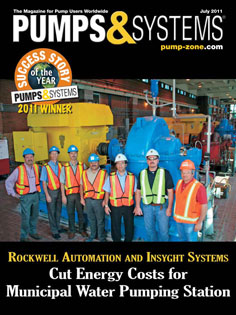“Sealing Sense,” July 2011
Click here for full article.
 In the [tool, under the Inputs – Outputs sheet] 2) Cost of Capital (PV discount rate):
In the [tool, under the Inputs – Outputs sheet] 2) Cost of Capital (PV discount rate):
- What does this mean? Is this not the 100 percent cost of the initial seal purchase?
- What is meant by PV discount rate, and what is the 12 percent based on?
Wim Mourits, Project Manager
EagleBurgmann Netherlands BV
FSA responds:
The Cost of Capital is a financial term that refers to the interest rate that a company must pay to borrow the money needed for a given project. Alternatively, if the company already has the funds needed for the project and does not need to borrow that money, then the Cost of Capital represents the income opportunity lost when the funds are used for the project and not placed in an alternate—and presumably profitable—investment.
In other words, the funds used for the project could be placed in an interest bearing account, but if they are used for the project, then that potential interest will not be realized. The interest rate on borrowed money and the opportunity lost interest rates are not necessarily the same value.
In reality, an individual company’s expected rate of return on a passive capital investment will be slightly lower than its expected interest rate on borrowed money. However, for simplicity, we have used only one number in the LCC Tool. For the project to be viable, it must normally have a higher than the expected rate of return of the same money on an alternative investment of equal risk.
This is a user defined field in the LCC Tool. It is the rate used to calculate the Present Value of the project over the life of the project. It is defined by the company or user and is often proportional to the time value of money. The default value for the LCC Tool is 12 percent and can be changed by the user.
I hope this helps to define the Cost of Capital as used by the LCC Tool. If not, please let me know.
Dave Casucci, Engineering Manager – Cranston
John Crane Inc.
Editor’s note: The recently updated LCC Tool can be downloaded at www.fluidsealing.com.
“Readers Respond,” August 2011
 I am writing regarding the letter submitted by Thomas J. Hill, PE that was published in the August 2011 edition. In his letter he inadvertently triggered a pet peeve of mine.
I am writing regarding the letter submitted by Thomas J. Hill, PE that was published in the August 2011 edition. In his letter he inadvertently triggered a pet peeve of mine.
I have been in the engineering profession for more than 40 years, earning both a Bachelors Degree (in Nuclear Engineering) and a Masters Degree (in Mechanical Engineering). Both of these degrees were earned using a slide rule, since that was the only tool available at the time. Our professors always stressed the subject of significant digits.
In his letter Mr. Hill reported that he calculated the pump head as “approximately 109.0068 feet” (emphasis added). The use of the word approximately followed by a number reported to four decimal places is a contradiction in terms. That may have been the number reported by Excel, but the inputs he used were not accurate enough to yield a result to the fourth decimal. Approximately 109 feet would have been a more accurate reporting of the results when you consider the accuracy of the inputs that were provided.
Too often, I see results provided by young engineers who fail to realize that the accuracy of the results is limited by the accuracy of the inputs and that just because the computer provides results with many decimals that is not the number that should be used. We need to remember basic engineering principles and respect the concept of significant digits.
Albert J. Ugelow, PE, PMP
Tom Hill responds:
As an engineer, I agree with Mr. Ugelow that it is normally folly to provide four decimal places on a reported value of pump head, especially when the pump performance data was totally fabricated, and it consisted entirely of integer values. The use of four decimal places on a reported pump head rise is even less relevant when one considers that instrumentation would likely be measuring pressure rather than head, and the accuracy of pressure measurements on pumps simply do not warrant the use of four decimal places.
However, the context of my letter was more at comparing an “approximate” numerical solution to an “exact” analytical solution, which mathematicians frequently do to distinguish such problems based on their solution method. When compared to the “exact” solution of an analytical problem, the result of an iterative numerical solution is “approximate,” regardless of the number of decimal places used for testing convergence.
For example, computer generated calculations of Pi going out to 10,000 decimal places are “approximate.” However, most engineers would be quite content to use only four decimal places for Pi, and whatever results were calculated using such a value could also be called “approximate.”
In the future though, I will try to be more careful when doing a cut-and-paste from Excel into a word doc, so as not to report more decimal places than are justified.

